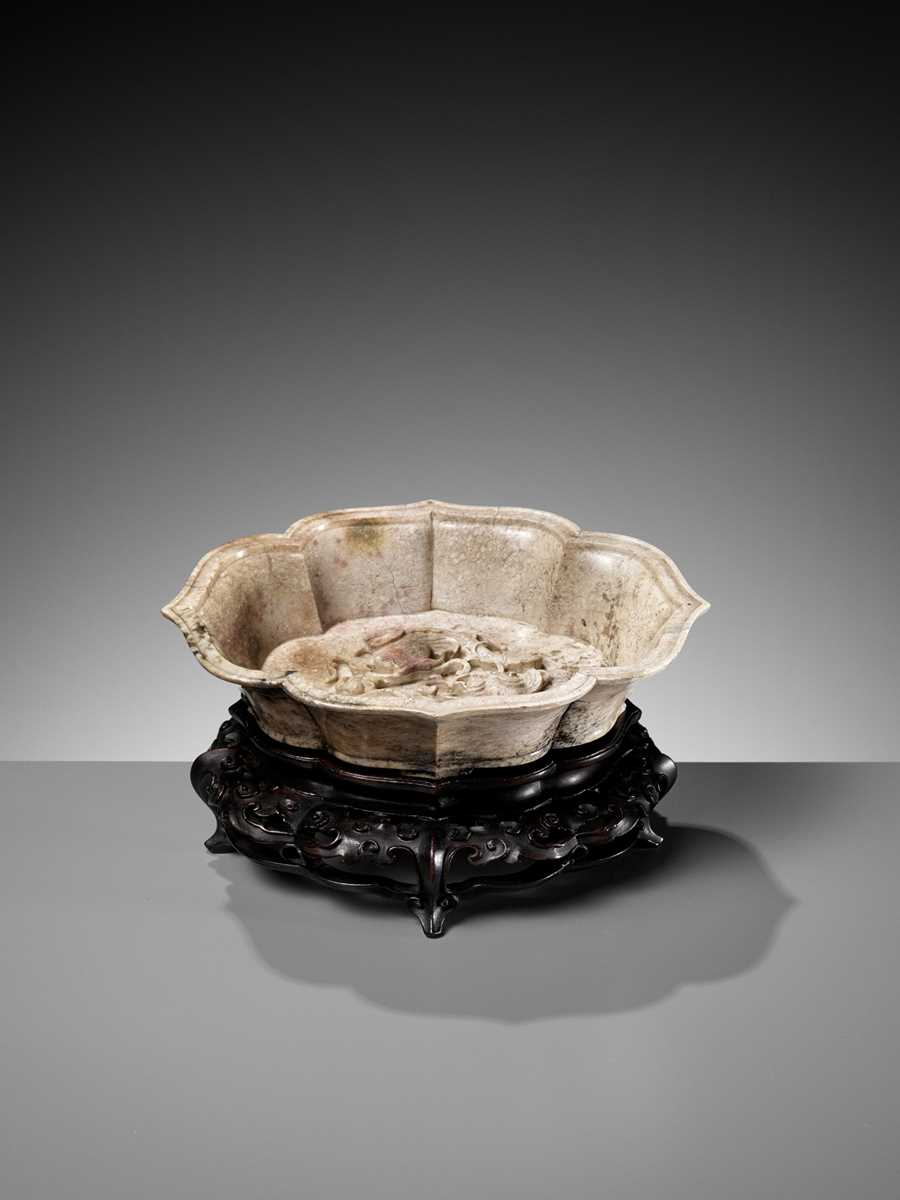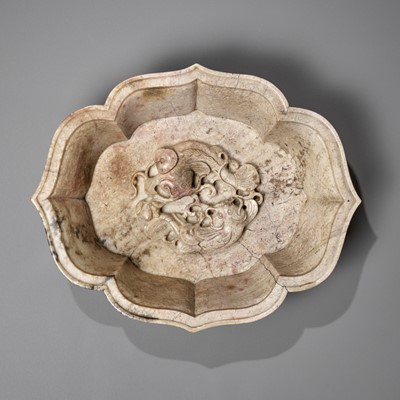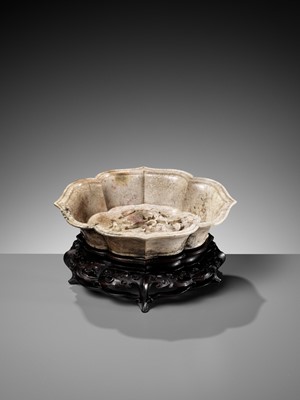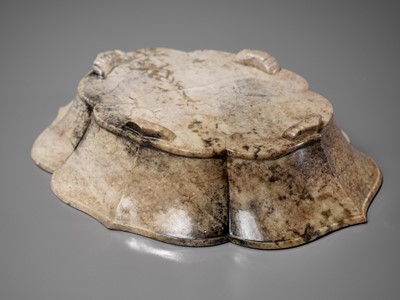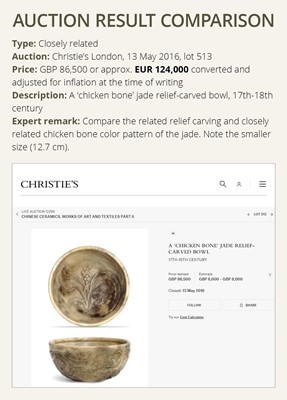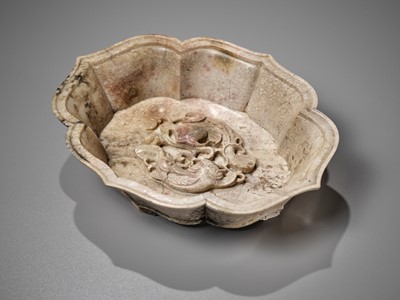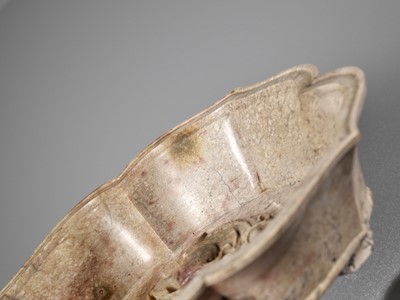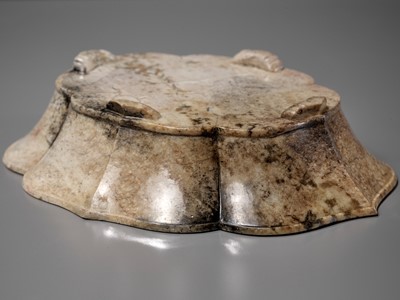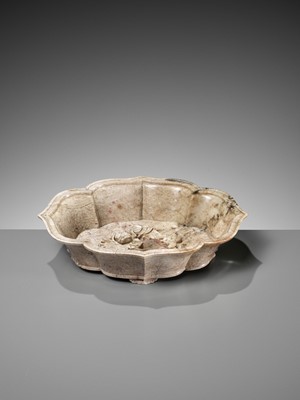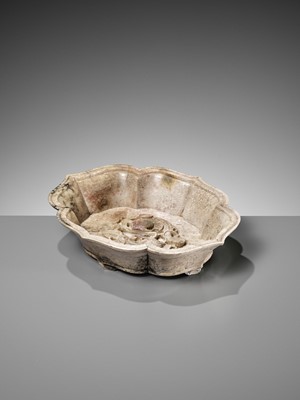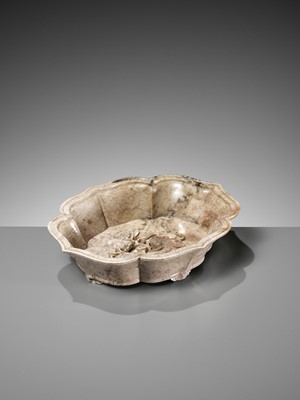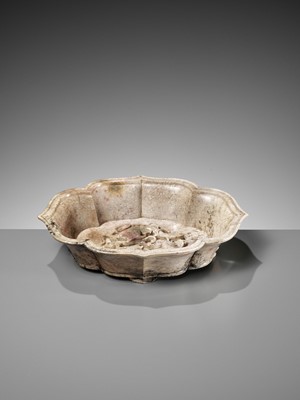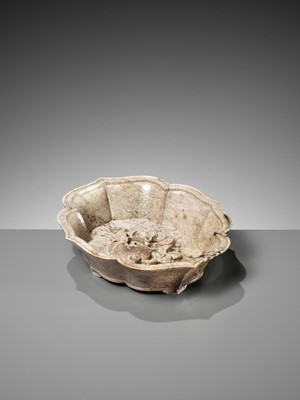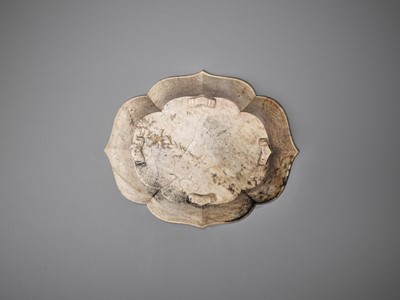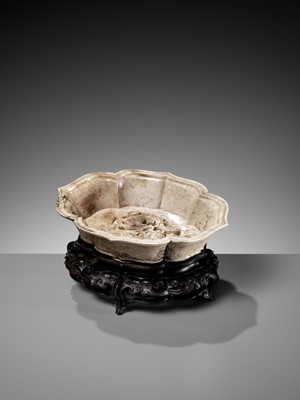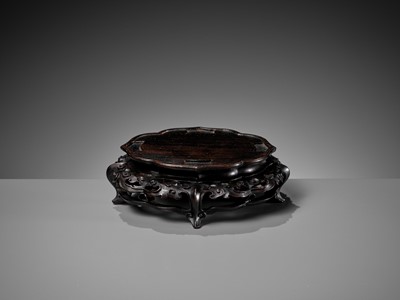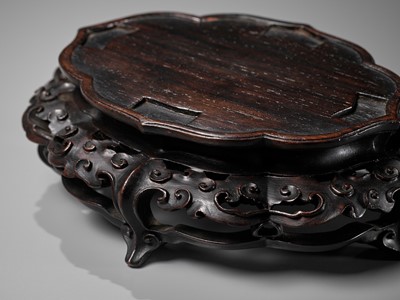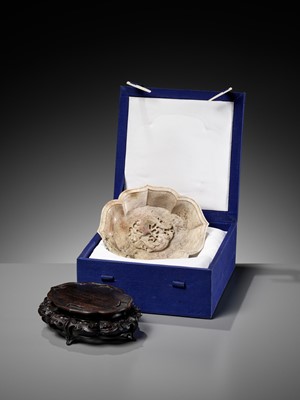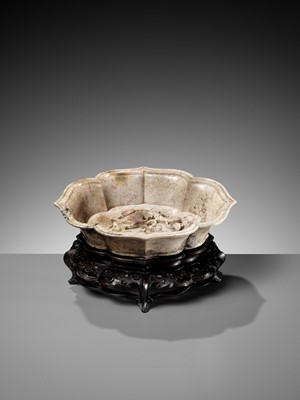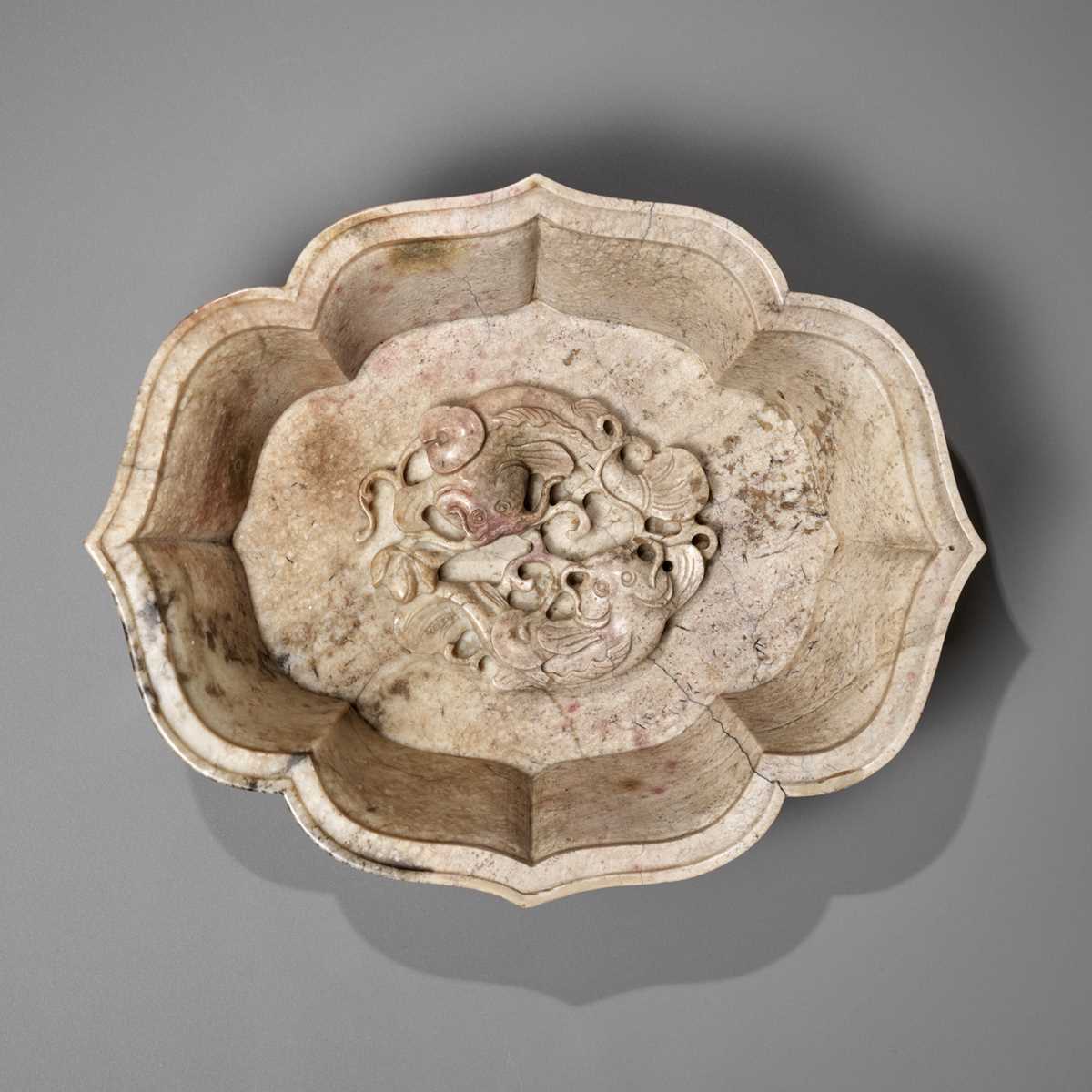1st Mar, 2024 10:00
The No Reserve Dragon Sale
94
A CHICKEN BONE JADE ‘DOUBLE FISH’ MARRIAGE BOWL, 17TH-18TH CENTURY
十七至十八世紀雞骨白雙魚玉洗
Sold for €7,150
including Buyer's Premium
Please note this Lot is to be sold at No Reserve. 本拍品不設底價
China. The flared sides supported on four short feet and rising to an everted bracket-lobed rim, the interior finely carved in relief to depict two confronting carps with lotus sprigs in their mouths. The opaque stone of a creamy ivory tone with dark veins and patches.
Provenance: From an old Swiss private collection and thence by descent to the last owner.
Condition: Good condition with minor old wear. The stone with natural inclusions and fissures, some of which have developed into small hairline cracks over time. Microscopic nicks here and there. The rim with a minor chip and associated old fill.
Weight: 224.9 g (excl. stand)
Dimensions: Length 15.3 cm
With a finely carved and open worked Zitan stand dating from the same period. (2)
Marriage bowls are so named because of their auspicious imagery symbolizing a long and happy marriage with abundant offspring to carry on the family line, and thus were often presented as betrothal or wedding gifts. In this case, the imagery is provided by the pair of fish and the lotus flowers as well as the ruyi form.
Chicken bone is a term for a rare and highly coveted nephrite jade of an opaque creamy beige color, often with extensive dark veining, which was particularly valued between the later Ming and early Qing dynasties. It is also sometimes said to be ‘burnt jade’ which has an opaque chalky appearance, usually with minute cracks all over the surface. It is known that nephrite - when heated to about 1000 degrees Celsius in a dry atmosphere - breaks down into diopside, enstatite (a magnesium silicate) and some quartz. In an experiment in the Freer Gallery Laboratory, samples of blue-green and white nephrite were submitted to temperatures up to 1025 degrees Celsius and both altered to an opaque chalky beige color with no change in the shape of the piece or the decoration of the surface. The chief mineral which resulted was diopside, and several nephrite jades in the Freer which appear to have been burnt also give a diopside x-ray diffraction pattern. Jadeite when heated in a similar manner behaves quite differently: it fuses to a glassy material, the surface smoothens out, and if the object is small enough it bends out of shape. See Elisabeth West, Jade: Its Character and Occurrence, The Bulletin of the University Museum of Pennsylvania, Volume 5, Issue 2, Winter 1963, page 5.
The Qianlong Emperor lauded jades, among many reasons, for the durability that this specific stone offers against the ravages of time and fire, unlike most others. The specific chicken bone color pattern of the present bowl may have been produced either by nature, or by deliberately heating the nephrite in a workshop, or by accidental exposure to fire. The collection of the Palace Museum in Beijing, for example, contains numerous chicken bone jades that were burnt in fires which erupted at the palace over the centuries.
Auction result comparison:
Type: Closely related
Auction: Christie’s London, 13 May 2016, lot 513
Price: GBP 86,500 or approx. EUR 124,000 converted and adjusted for inflation at the time of writing
Description: A ‘chicken bone’ jade relief-carved bowl, 17th-18th century
Expert remark: Compare the related relief carving and closely related chicken bone color pattern of the jade. Note the smaller size (12.7 cm).
十七至十八世紀雞骨白雙魚玉洗
中國 。花口玉洗,四短足,口沿外翻;玉洗内精美浮雕兩條面對面的鯉魚,魚嘴裡銜著小蓮花。乳白象牙色的不透明玉料,帶有深色紋理和斑塊。
來源:瑞士私人舊藏,保存至今。
品相:狀況良好,有輕微磨損,具有天然內含物和裂縫的石頭,隨著時間的推移,其中一些已經發展成細小的裂縫。多處細微刻痕,邊緣有少量磕損和填充。
重量:224.9 克 (不含底座)
尺寸:長 15.3 厘米
鏤空雕同時代紫檀底座。
此類玉洗之所以被稱爲婚碗,是因為其寓意吉祥如意,婚姻美滿,子孫繁盛,常作為聘禮或結婚禮物。現在這個拍品的中央有一對魚和蓮花,正好寓意吉祥如意與婚姻美滿。
雞骨白是一種稀有的軟玉,呈不透明的乳白色,通常帶有廣泛的深色脈紋,在明末清初尤其受到重視。它具有不透明的鈣化斑,通常表面有微小的裂縫。有關雞骨白請參見 Elisabeth West,《Jade: Its Character and Occurrence》,賓夕法尼亞大學博物館公報,第 5 卷,第 2 期,1963 年冬季,頁5。
乾隆皇帝稱讚玉石的原因有很多,因為這種特殊的石料與大多數其他石頭不同,它能夠抵抗時間和火的破壞,經久耐用。 本碗的特定雞骨白斑紋可能是自然產生的,也可能是在作坊中故意加熱玉,特意做出的效果。例如,北京故宮博物院的藏品中就有在故宮大火中燒毀的大量雞骨玉器。
拍賣結果比較:
形制:非常相近
拍賣:倫敦佳士得,2016年5月13日,lot 513
價格:GBP 86,500(相當於今日EUR 124,000)
描述:十七至十八世紀雞骨白蓮花纏枝玉碗
專家評論:比較相近的浮雕和非常相近的雞骨白顏色。請注意尺寸較小 (12.7 厘米)。
Please note this Lot is to be sold at No Reserve. 本拍品不設底價
China. The flared sides supported on four short feet and rising to an everted bracket-lobed rim, the interior finely carved in relief to depict two confronting carps with lotus sprigs in their mouths. The opaque stone of a creamy ivory tone with dark veins and patches.
Provenance: From an old Swiss private collection and thence by descent to the last owner.
Condition: Good condition with minor old wear. The stone with natural inclusions and fissures, some of which have developed into small hairline cracks over time. Microscopic nicks here and there. The rim with a minor chip and associated old fill.
Weight: 224.9 g (excl. stand)
Dimensions: Length 15.3 cm
With a finely carved and open worked Zitan stand dating from the same period. (2)
Marriage bowls are so named because of their auspicious imagery symbolizing a long and happy marriage with abundant offspring to carry on the family line, and thus were often presented as betrothal or wedding gifts. In this case, the imagery is provided by the pair of fish and the lotus flowers as well as the ruyi form.
Chicken bone is a term for a rare and highly coveted nephrite jade of an opaque creamy beige color, often with extensive dark veining, which was particularly valued between the later Ming and early Qing dynasties. It is also sometimes said to be ‘burnt jade’ which has an opaque chalky appearance, usually with minute cracks all over the surface. It is known that nephrite - when heated to about 1000 degrees Celsius in a dry atmosphere - breaks down into diopside, enstatite (a magnesium silicate) and some quartz. In an experiment in the Freer Gallery Laboratory, samples of blue-green and white nephrite were submitted to temperatures up to 1025 degrees Celsius and both altered to an opaque chalky beige color with no change in the shape of the piece or the decoration of the surface. The chief mineral which resulted was diopside, and several nephrite jades in the Freer which appear to have been burnt also give a diopside x-ray diffraction pattern. Jadeite when heated in a similar manner behaves quite differently: it fuses to a glassy material, the surface smoothens out, and if the object is small enough it bends out of shape. See Elisabeth West, Jade: Its Character and Occurrence, The Bulletin of the University Museum of Pennsylvania, Volume 5, Issue 2, Winter 1963, page 5.
The Qianlong Emperor lauded jades, among many reasons, for the durability that this specific stone offers against the ravages of time and fire, unlike most others. The specific chicken bone color pattern of the present bowl may have been produced either by nature, or by deliberately heating the nephrite in a workshop, or by accidental exposure to fire. The collection of the Palace Museum in Beijing, for example, contains numerous chicken bone jades that were burnt in fires which erupted at the palace over the centuries.
Auction result comparison:
Type: Closely related
Auction: Christie’s London, 13 May 2016, lot 513
Price: GBP 86,500 or approx. EUR 124,000 converted and adjusted for inflation at the time of writing
Description: A ‘chicken bone’ jade relief-carved bowl, 17th-18th century
Expert remark: Compare the related relief carving and closely related chicken bone color pattern of the jade. Note the smaller size (12.7 cm).
十七至十八世紀雞骨白雙魚玉洗
中國 。花口玉洗,四短足,口沿外翻;玉洗内精美浮雕兩條面對面的鯉魚,魚嘴裡銜著小蓮花。乳白象牙色的不透明玉料,帶有深色紋理和斑塊。
來源:瑞士私人舊藏,保存至今。
品相:狀況良好,有輕微磨損,具有天然內含物和裂縫的石頭,隨著時間的推移,其中一些已經發展成細小的裂縫。多處細微刻痕,邊緣有少量磕損和填充。
重量:224.9 克 (不含底座)
尺寸:長 15.3 厘米
鏤空雕同時代紫檀底座。
此類玉洗之所以被稱爲婚碗,是因為其寓意吉祥如意,婚姻美滿,子孫繁盛,常作為聘禮或結婚禮物。現在這個拍品的中央有一對魚和蓮花,正好寓意吉祥如意與婚姻美滿。
雞骨白是一種稀有的軟玉,呈不透明的乳白色,通常帶有廣泛的深色脈紋,在明末清初尤其受到重視。它具有不透明的鈣化斑,通常表面有微小的裂縫。有關雞骨白請參見 Elisabeth West,《Jade: Its Character and Occurrence》,賓夕法尼亞大學博物館公報,第 5 卷,第 2 期,1963 年冬季,頁5。
乾隆皇帝稱讚玉石的原因有很多,因為這種特殊的石料與大多數其他石頭不同,它能夠抵抗時間和火的破壞,經久耐用。 本碗的特定雞骨白斑紋可能是自然產生的,也可能是在作坊中故意加熱玉,特意做出的效果。例如,北京故宮博物院的藏品中就有在故宮大火中燒毀的大量雞骨玉器。
拍賣結果比較:
形制:非常相近
拍賣:倫敦佳士得,2016年5月13日,lot 513
價格:GBP 86,500(相當於今日EUR 124,000)
描述:十七至十八世紀雞骨白蓮花纏枝玉碗
專家評論:比較相近的浮雕和非常相近的雞骨白顏色。請注意尺寸較小 (12.7 厘米)。
Zacke Live Online Bidding
Our online bidding platform makes it easier than ever to bid in our auctions! When you bid through our website, you can take advantage of our premium buyer's terms without incurring any additional online bidding surcharges.
To bid live online, you'll need to create an online account. Once your account is created and your identity is verified, you can register to bid in an auction up to 12 hours before the auction begins.
Intended Spend and Bid Limits
When you register to bid in an online auction, you will need to share your intended maximum spending budget for the auction. We will then review your intended spend and set a bid limit for you. Once you have pre-registered for a live online auction, you can see your intended spend and bid limit by going to 'Account Settings' and clicking on 'Live Bidding Registrations'.
Your bid limit will be the maximum amount you can bid during the auction. Your bid limit is for the hammer price and is not affected by the buyer’s premium and VAT. For example, if you have a bid limit of €1,000 and place two winning bids for €300 and €200, then you will only be able to bid €500 for the rest of the auction. If you try to place a bid that is higher than €500, you will not be able to do so.
Online Absentee and Telephone Bids
You can now leave absentee and telephone bids on our website!
Absentee Bidding
Once you've created an account and your identity is verified, you can leave your absentee bid directly on the lot page. We will contact you when your bids have been confirmed.
Telephone Bidding
Once you've created an account and your identity is verified, you can leave telephone bids online. We will contact you when your bids have been confirmed.
Classic Absentee and Telephone Bidding Form
You can still submit absentee and telephone bids by email or fax if you prefer. Simply fill out the Absentee Bidding/Telephone bidding form and return it to us by email at office@zacke.at or by fax at +43 (1) 532 04 52 20. You can download the PDF from our Upcoming Auctions page.
How-To Guides
How to Create Your Personal Zacke Account
How to Register to Bid on Zacke Live
How to Leave Absentee Bids Online
How to Leave Telephone Bids Online
中文版本的操作指南
创建新账号
注册Zacke Live在线直播竞拍(免平台费)
缺席投标和电话投标
Third-Party Bidding
We partner with best-in-class third-party partners to make it easy for you to bid online in the channel of your choice. Please note that if you bid with one of our third-party online partners, then there will be a live bidding surcharge on top of your final purchase price. You can find all of our fees here. Here's a full list of our third-party partners:
- 51 Bid Live
- EpaiLive
- ArtFoxLive
- Invaluable
- LiveAuctioneers
- the-saleroom
- lot-tissimo
- Drouot
Please note that we place different auctions on different platforms. For example, in general, we only place Chinese art auctions on 51 Bid Live.
Bidding in Person
You must register to bid in person and will be assigned a paddle at the auction. Please contact us at office@zacke.at or +43 (1) 532 04 52 for the latest local health and safety guidelines.
